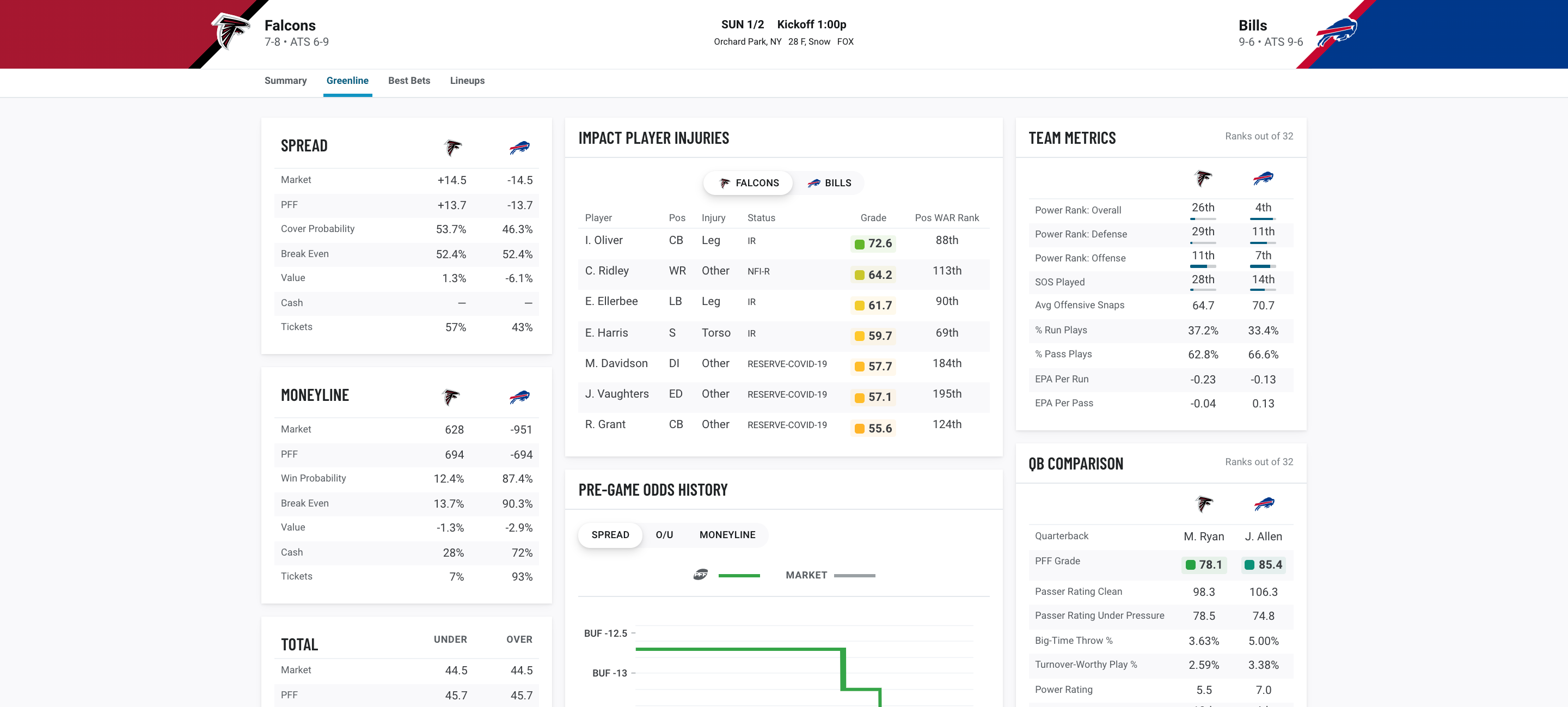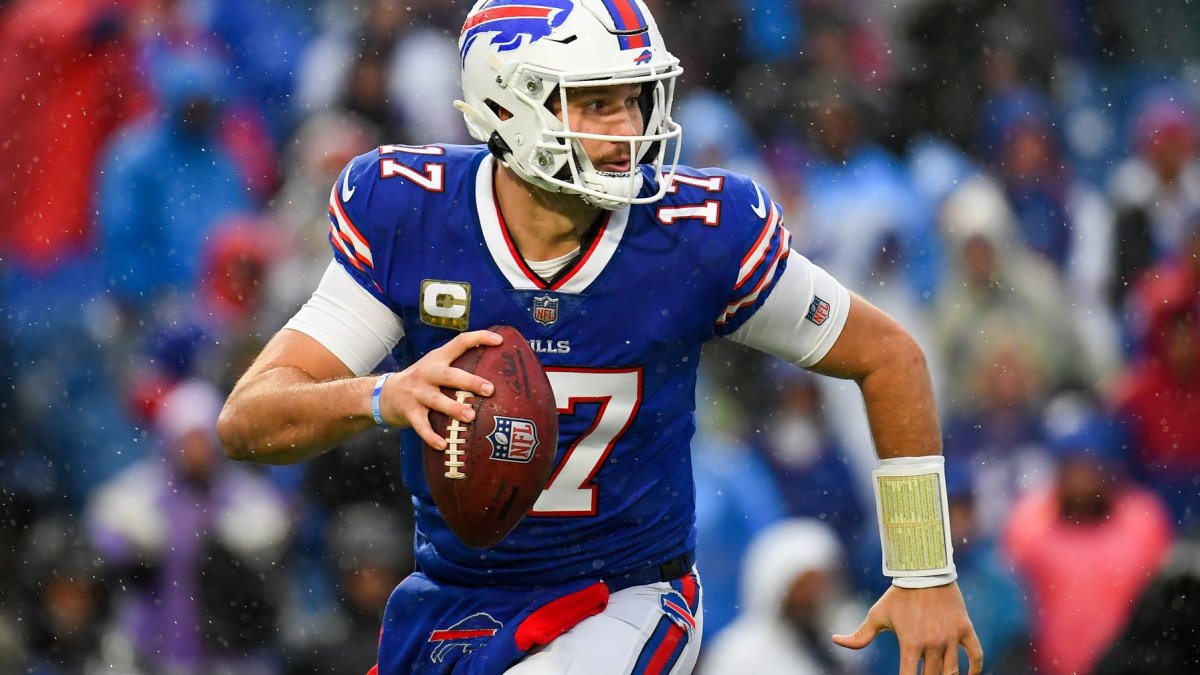Don’t look now, but after weeks of wondering whether the Buffalo Bills were even going to make the playoffs in 2022, their most recent win against the New England Patriots has not only catapulted them back to the top of the AFC East, but it has also renewed their AFC championship hopes.
There are plenty of factors that contribute to the Bills' recent rebound, but at the center of it all is quarterback Josh Allen and a newly emphasized vision of how to make the most of him.
Click here for more PFF tools:
Rankings & Projections | WR/CB Matchup Chart | NFL & NCAA Betting Dashboards | NFL Player Props tool | NFL & NCAA Power Rankings
Best Bets Tool
Back in early November, the Bills boasted a 5-2 record that featured a dominant win over the Kansas City Chiefs, their biggest threat to the AFC crown. Their quarterback, who was 10th among quarterbacks in PFF grade, sat atop the betting market as the favorite to win the 2021 NFL MVP Award.
Their two losses to the Tennessee Titans and Pittsburgh Steelers could have been pretty easily changed had the ball bounced a bit more their way. The bottom line was that the Bills’ Super Bowl train was off and moving, and Allen was the conductor.
Buffalo Bills: Offensive statistics in 2021
| Week 1 – Week 8 | Week 9 – Week 14 | |
| Overall team grade | 74.7 (18th) | 72.8 (13th) |
| Team passing grade | 79.3 (15th) | 65.2 (16th) |
| Team receiving grade | 72.4 (19th) | 73.0 (8th) |
| Team rushing grade | 85.0 (4th) | 86.0 (2nd) |
| EPA per play | 0.058 (7th) | -0.014 (11th) |
| Succesful play % | 48.4% (6th) | 46.6% (6th) |
| Josh Allen PFF grade | 84.7 (10th) | 78.7 (6th) |
But in the month and a half that followed, the Bills went just 2-4 in a six-game stretch that included key losses to the Tampa Bay Buccaneers, New England Patriots and Indianapolis Colts, as well as a perplexing loss to one of the worst teams in the league — the Jacksonville Jaguars. After generating 0.058 expected points added (EPA) per play over the season's first eight weeks, seventh among the NFL's 32 offenses, the Bills stumbled to -0.014 EPA per play from Week 9 to Week 14.
With his team at 7-6, not only was Josh Allen’s MVP campaign down on its luck, but it also appeared as though the Bills, once the favorite to win the AFC, were down on their playoff hopes, too.
Smart football minds cited a lack of balance as the main culprit for why the Bills weren’t able to put up enough points to come away victorious in their recent matches. Relying heavily on Allen’s arm to orchestrate one of the best passing attacks in the league, the Bill seemed to lose their offensive identity when rushing — if rushing at all. Through the first 14 weeks of the season, the Bills had the second-fewest rushing attempts by running backs in the NFL. This was odd since, at the time, the Bills were 11th in yards per attempt, and their running backs carried a collective PFF rushing grade of 80.8 — the ninth-best in the league. They just weren’t handing the ball off.
The drawbacks of that strategy became glaring in the Bills' loss against Tampa Bay, as they were outscored 24-3 in the first half and didn’t hand the ball off a single time to a running back through the first two quarters.
Essentially, the Bills became the scientific lab rat for the NFL's pass-heavy movement. Buffalo was becoming the live experiment answering the question: At what point does passing too much become a detriment?
For the Bills, specifically, defenses have deployed the same strategy against Allen as they have against the likes of Patrick Mahomes and Justin Herbert and other great arms: allocate resources in coverage and dare the other team to run the ball with more numbers in coverage and fewer numbers in the box.
Teams simply did not fear Buffalo handing the ball off because, well, they weren’t doing it. It’s hard to blame them. Allen was and is playing some of the best ball of any quarterback in the league, and they have reliable passing weapons led by one of league's best receivers in Stefon Diggs. The Bills believed they were playing to their strengths.

But when the Bills have struggled this season, the lack of a run game has been a common denominator. Sure, the offensive line hasn’t been top tier, but at times it just doesn't even seem like they trust anyone other than Allen to have control of the ball in the backfield.
Following their recent win over the Patriots to take back the division lead, the Bills seem to have unlocked the key to an impactful ground game. Keeping the ball in Allen’s hands was once thought to be the culprit of the Bills’ rushing woes — it might just be the answer, especially now with Allen as more of a runner.
Allen being used in Buffalo’s rushing attack is nothing new. The 6-foot-5, 240-pound quarterback is extremely difficult to wrangle in the backfield. Allen was in the 80th percentile of all NFL quarterbacks at the NFL Combine in both the broad jump and 3-cone drill and ran a 4.75 40-yard dash. Impressive for a player his size.
Allen’s size pegs him as more of a battering ram kind of quarterback when tucking the ball to run. He has always been a handful to bring down, but this year — especially of late — he has shown to be a dangerous runner in a variety of ways.
This season Allen has an elite 90.0 grade when rushing. That’s second only to New Orleans Saints’ quarterback Taysom Hill. Allen also has the third-most rushing yards among quarterbacks (619), the third-most first down runs (41) and the third-most explosive runs (23). He also leads the league in forced missed tackle per attempt with 0.30. On top of all that, no quarterback room in the league with at least 100 collective rushes on the season has a higher EPA per play when rushing than the Bills. When Allen tucks it to run, he’s explosive and effective.
In two of the Bills' last three games, he’s seen double-digit carries and was the Bills' leading rusher in both of them. Though the team lost to Tampa Bay, the return to the ground game was a reason why the Bills matched a big comeback that game. It was also a reason why they were able to get revenge on the Patriots two weeks later. The Pats played a lot of man coverage against the Bills, and Allen was able to consistently make them pay on the ground by escaping the pocket for scrambles. Playing man coverage forces defenders to often have their back turned and not on the quarterback.
Allen gave them that ground game spark — and clutch carries, too.
4th and 1 with the division on the line… the ball in Josh Allen’s hands is the right call. pic.twitter.com/8s5kzUhHOL
— Bradley Gelber (@BradleyGelber) December 26, 2021
Allen being a viable option on the ground, whether with a designed run or a scramble, isn’t new. In fact, he just became the first player in NFL history with at least 100 passing touchdowns and at least 20 rushing touchdowns in their first four seasons. He also now trails only Steve Young for games with at least 300 yards passing and 50 yards rushing.
Offensive coordinator Briann Daboll and the Bills still want to be on the forefront of the modern NFL, which is winning the game through your quarterback's arm — especially one as talented as Allen. They showed as much during the middle part of their schedule. Still, even though investing in the pass game is the higher return of investment, there are times when “ground and pound” is the move. You have to at least have the option to execute those opportunities. Allen has been that answer.
At one point, taking the ball out of Allen’s hands wasn’t something the coaches were willing to do, and that appeared to be a weakness. Now, with more balance involved, it not only looks like a strength but an answer to how they’ve re-taken the division and once again become a team in the AFC no one wants to face in January.




 © 2025 PFF - all rights reserved.
© 2025 PFF - all rights reserved.